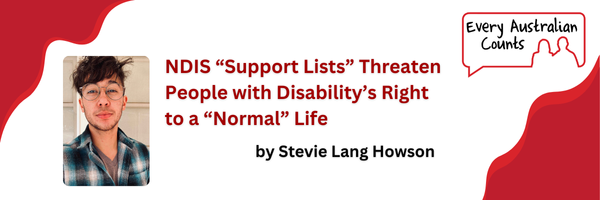NDIS “Support Lists” Threaten People with Disability’s Right to a “Normal” Life By Stevie Lang Howson

Every Australian Counts supporter, Stevie Lang Howson Shares his concerns about the NDIS “Support Lists” that are currently open for consultation.
The central question at the heart of the NDIS reform agenda is how well are we allowed to live?
How well are disabled people allowed to live? Are the ways they manage their lives and disability related needs allowed to be comfortable, fun and personalised? Or do they have to be medicalised and grim?
The example of people getting “holidays” on the NDIS perfectly illustrates this dynamic.
The concept of respite is a common and well-established disability support. It means taking a break away from usual care arrangements, to give everyone, including the person with disability, a change of pace and scenery.
Doing the same thing every day, having your same tired mum help you out of bed every single morning, having the same people coming into your house and the same schedule of activities, in the same part of the same place you’ve lived all your life is not an easy life. It’s a tough life. It’s work – for the person receiving the care, and for the people providing it.
When people take a break from the tough parts of their life -and experience new things in a different setting to reset and recharge – it’s generally called a holiday. When people take a break for disability related purposes – we’d usually call it respite.
Theoretically, respite could be provided in all sorts of ways. In the past, it was provided in facilities like group homes. But one of the ways that the disability services landscape has changed since the NDIS was introduced is that providing people with personal budgets has fulfilled one of the original intentions of the scheme. Disabled people and their carers can now choose forms of respite that actually feel good and comfortable. This might look like a holiday.
The fact that a respite looks like a holiday does a few things. It helps people have as close to a normal life as they can (this is an original intention of the NDIS). It helps carers actually feel okay about leaving the person they care for in the respite care. It is more likely that the person going away for respite will actually enjoy it, and want to go back, meaning that carers get more regular breaks. For the person with disability, it might lead to new experiences and new perspectives that enrich their lives and, in some cases, mean that they can envisage different ways of living, including more independently.
Ultimately, disabled people deserve more than to be kept alive.
Having respite in an institutional environment does not save money. It likely costs more money. The functional decline and carer burnout associated with lack of respite certainly will cost more.
What goals like limiting respite to group home settings do is not improve outcomes or improve lives or even save money. What it does do is put down disabled people’s agency and communicate very clearly that this is a scheme that might keep you alive, but will certainly not guarantee any quality of life, let alone a normal life, or a good one.
Stay informed on the latest NDIS legislation updates by visiting our website here: NDIS Bill ’24 – Every Australian Counts.
Provide your feedback on the draft NDIS support lists through the DSS Engage page here: Consultation on draft lists of NDIS supports | engage.dss.gov.au

Join the conversation